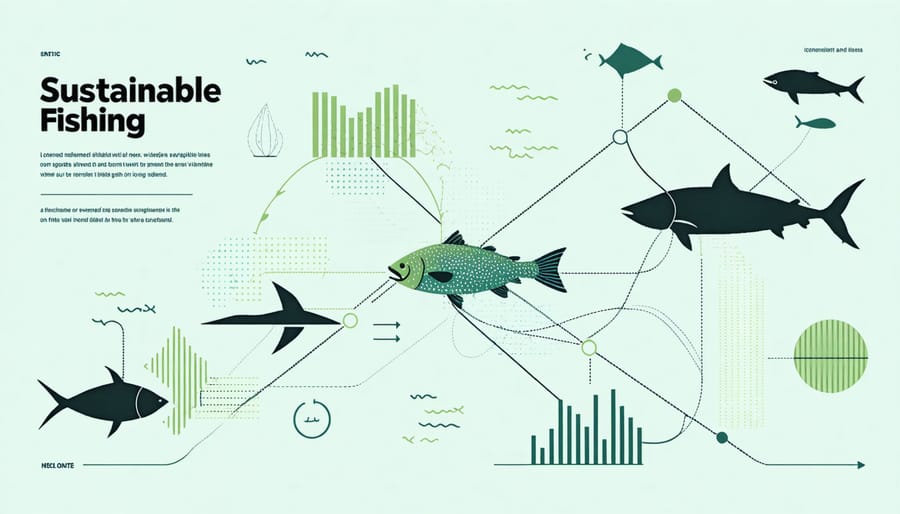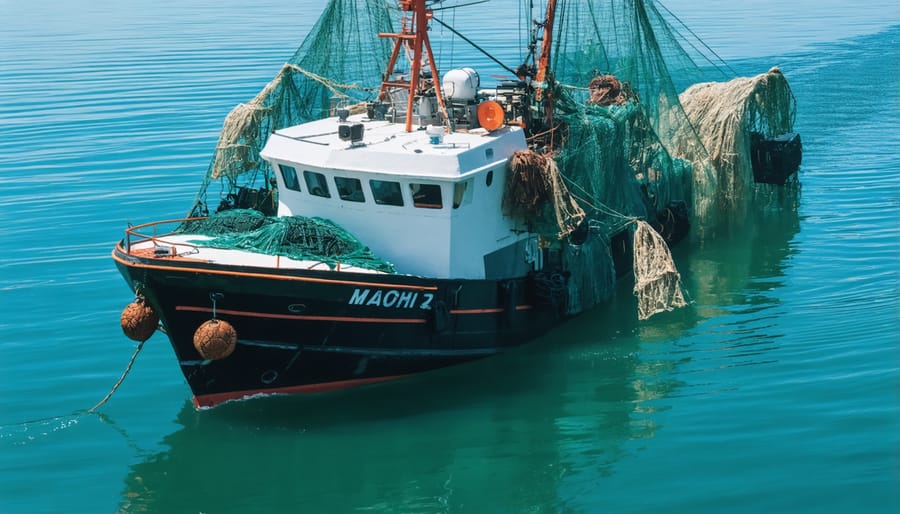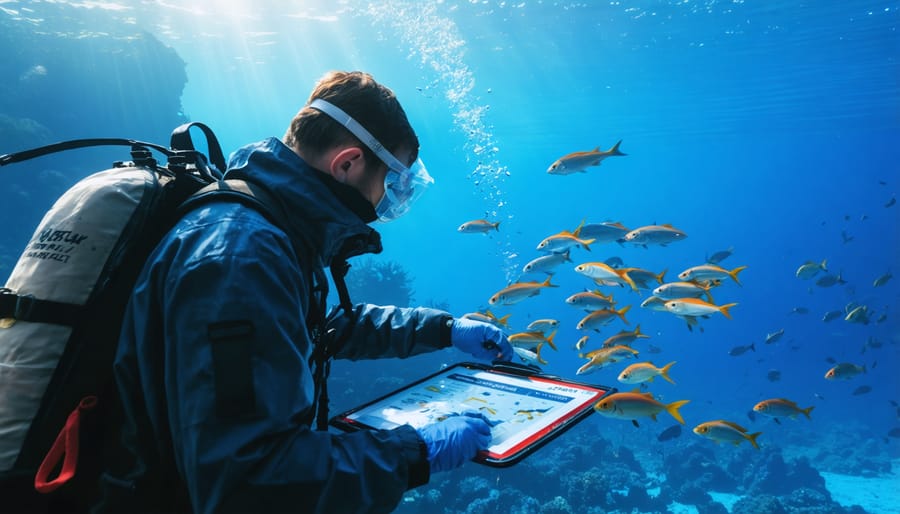
Sustainable fishing represents the delicate balance between meeting our present seafood needs and preserving marine ecosystems for future generations. Unlike destructive fishing practices that deplete ocean resources, sustainable fishing methods carefully monitor fish populations, respect marine habitats, and maintain the ocean’s natural balance. This approach ensures that fish stocks can naturally replenish while supporting the livelihoods of fishing communities worldwide.
At its core, sustainable fishing embodies three fundamental principles: environmental stewardship, economic viability, and social responsibility. Modern sustainable fishing practices incorporate scientific data to establish catch limits, employ selective fishing gear that minimizes bycatch, and protect critical marine habitats during spawning seasons. These methods have proven successful in regions like Alaska’s salmon fishery and New Zealand’s quota management system, where fish populations have remained stable or even increased while supporting robust fishing industries.
As global demand for seafood continues to rise, understanding and implementing sustainable fishing practices becomes increasingly crucial for ocean health and food security. Through careful management and innovative technologies, we can ensure that our oceans remain productive and healthy for generations to come.
What Makes Fishing Truly Sustainable?

The Three Pillars of Sustainable Fishing
Sustainable fishing rests on three fundamental pillars that work together to ensure the long-term viability of fishing practices while protecting marine ecosystem health and supporting communities.
The environmental pillar focuses on maintaining healthy fish populations and protecting marine habitats. This includes setting science-based catch limits, using selective fishing gear to minimize bycatch, and preserving critical breeding grounds. Successful environmental management ensures that fish populations can naturally replenish themselves while maintaining biodiversity and ecosystem balance.
The economic pillar addresses the financial sustainability of fishing operations and the broader industry. This encompasses creating stable livelihoods for fishers, ensuring fair market prices, and developing efficient supply chains. When fishing operations are economically viable, they’re more likely to invest in sustainable practices and equipment, creating a positive cycle of responsible resource management.
The social pillar recognizes fishing’s cultural importance and its role in food security. This includes preserving traditional fishing practices, ensuring equitable access to fishing resources, and maintaining fishing communities’ social fabric. It also involves fair labor practices and safety standards for fishing crews, as well as protecting the rights of small-scale fishers who often compete with industrial operations.
These pillars are interdependent – success in one area supports the others. For instance, healthy fish populations (environmental) lead to better catches (economic), which help maintain thriving fishing communities (social). Understanding and balancing these three aspects is crucial for creating truly sustainable fishing practices that benefit both current and future generations.
Science-Based Catch Limits
Science-based catch limits represent the cornerstone of sustainable fishing management, relying on robust data collection and analysis to determine how many fish can be harvested without compromising population health. Marine biologists and fishery scientists conduct regular stock assessments, measuring factors like population size, growth rates, and reproductive capacity to establish sustainable quotas.
These limits are calculated using sophisticated mathematical models that account for multiple variables, including natural mortality rates, fishing pressure, and environmental conditions. Scientists also consider the ecosystem’s carrying capacity and the species’ role in the food web when setting these boundaries.
The process involves extensive monitoring through various methods:
– Fishery-dependent data from commercial catches
– Scientific surveys using research vessels
– Acoustic monitoring of fish populations
– Genetic sampling to assess population diversity
– Tracking of environmental indicators
Catch limits are regularly reviewed and adjusted based on new data and changing conditions. This adaptive management approach ensures that quotas remain responsive to environmental changes and fishing pressures. When populations show signs of stress, limits can be reduced to allow recovery, while healthy populations might support increased quotas.
Modern technology plays a crucial role in maintaining these limits, with satellite monitoring, electronic logbooks, and observer programs helping ensure compliance. This scientific approach to quota setting has helped numerous fish populations recover from previous overfishing while supporting sustainable commercial fishing operations.
Sustainable Fishing Methods in Practice
Selective Gear Technology
Modern fishing technology has evolved to address one of the industry’s biggest challenges: unintended bycatch. Advanced selective gear designs help fishers target specific species while minimizing their impact on marine life not intended for capture. Turtle Excluder Devices (TEDs) have become standard in many trawl nets, allowing sea turtles to escape while retaining the target catch. Similarly, acoustic pingers warn marine mammals about nearby nets, while modified hook designs reduce seabird bycatch in longline fishing.
Smart nets equipped with sensors can now identify fish species and sizes before they’re caught, allowing fishers to avoid unwanted catch. These nets feature escape panels and sorting grids that help juvenile fish and non-target species swim free. LED lights attached to nets have proven effective in reducing the accidental capture of endangered species while maintaining commercial catch rates.
The integration of real-time monitoring systems helps fishing vessels adjust their gear based on environmental conditions and the presence of protected species, making fishing operations more precise and environmentally responsible.

Time and Area Management
Effective time and area management are crucial components of sustainable fishing practices. By establishing strategic fishing zones and seasonal restrictions, we can protect marine ecosystems while maintaining viable fish populations. Marine protected areas (MPAs) serve as safe havens where fish populations can reproduce and recover, essentially acting as natural fish nurseries.
Seasonal considerations play a vital role in sustainable fishing. Many species have specific breeding seasons when fishing activities should be limited or prohibited entirely. For example, during salmon spawning runs, certain rivers and coastal areas implement strict fishing restrictions to ensure successful reproduction.
Time management in sustainable fishing also involves rotating fishing grounds to prevent overexploitation. This practice allows marine ecosystems to recover naturally between fishing periods. Some communities implement traditional systems like the Pacific Islands’ “tabu” areas, where fishing is prohibited for set periods.
Modern technology, including satellite tracking and marine forecasting, helps fishers plan their activities around these temporal and spatial restrictions while maximizing their efficiency during permitted fishing periods. This strategic approach ensures both environmental protection and economic viability for fishing communities.
Success Stories from the Field
The Marine Stewardship Council’s certification of the Alaska salmon fishery stands as a landmark success story in sustainable fishing. Since its certification in 2000, the fishery has maintained healthy salmon populations while supporting local communities. Using carefully monitored catch limits and seasonal restrictions, Alaska’s salmon industry now serves as a global model for balancing economic needs with environmental preservation.
In the Mediterranean, the Mersea Island fishing community demonstrates how small-scale sustainable practices can thrive. Local fishermen switched to larger mesh sizes and seasonal fishing schedules, resulting in a 40% increase in fish populations over five years while maintaining profitable operations. Their success inspired neighboring communities to adopt similar practices.
The South Pacific tuna management program showcases international cooperation at its finest. Through collaboration between 17 Pacific island nations, this initiative implemented vessel monitoring systems and observer programs. The result? Tuna populations have stabilized, and illegal fishing has decreased by 70% since 2010.
In New Zealand, the Māori people’s traditional fishing practices have been integrated into modern management systems. Their customary knowledge, combined with scientific monitoring, has led to the successful restoration of several local fish species. This approach demonstrates how indigenous wisdom and contemporary science can work together for sustainable outcomes.
These success stories prove that sustainable fishing isn’t just an ideal – it’s an achievable reality that benefits both marine ecosystems and human communities.
Education and Implementation

Training Programs and Certification
Several institutions offer comprehensive training programs in marine conservation education and sustainable fishing practices. The Marine Stewardship Council (MSC) provides professional certification programs for fishery managers and operators, while organizations like NOAA offer specialized courses in sustainable fishing techniques and ecosystem management.
Popular certifications include the Sustainable Fisheries Management Certificate, which covers topics like stock assessment, gear modification, and ecosystem-based management approaches. The International Maritime College offers a diploma in Sustainable Fishing Operations, combining practical skills with theoretical knowledge of marine conservation.
Online learning platforms have made these educational opportunities more accessible, with courses ranging from basic sustainable fishing practices to advanced marine resource management. Many programs incorporate hands-on training through partnerships with local fishing communities and conservation organizations.
For those seeking professional recognition, the Certified Sustainable Fisheries Professional (CSFP) credential demonstrates expertise in implementing sustainable fishing practices and managing marine resources responsibly. This certification is increasingly valued by environmental organizations, government agencies, and fishing industry employers.
Sustainable fishing represents our commitment to preserving marine ecosystems while meeting global food security needs. By embracing scientific quotas, selective gear, and responsible practices, we can ensure healthy fish populations for generations to come. The success of sustainable fishing depends on collaboration between fishers, scientists, policymakers, and consumers. Each of us can contribute by choosing sustainably caught seafood, supporting local fishing communities that follow best practices, and spreading awareness about the importance of ocean conservation. Whether through volunteering with marine conservation groups, educating others, or making informed seafood choices, our individual actions collectively make a difference. Together, we can create a future where healthy oceans support thriving marine life and sustainable fisheries continue to feed our world.
jessica
Ava Singh is an environmental writer and marine sustainability advocate with a deep commitment to protecting the world's oceans and coastal communities. With a background in environmental policy and a passion for storytelling, Ava brings complex topics to life through clear, engaging content that educates and empowers readers. At the Marine Biodiversity & Sustainability Learning Center, Ava focuses on sharing impactful stories about community engagement, policy innovations, and conservation strategies. Her writing bridges the gap between science and the public, encouraging people to take part in preserving marine biodiversity. When she’s not writing, Ava collaborates with local initiatives to promote eco-conscious living and sustainable development, ensuring her work makes a difference both on the page and in the real world.
